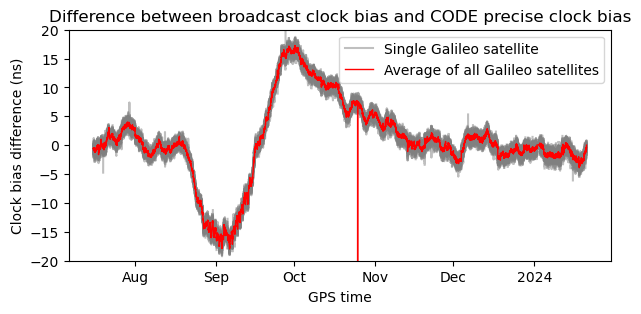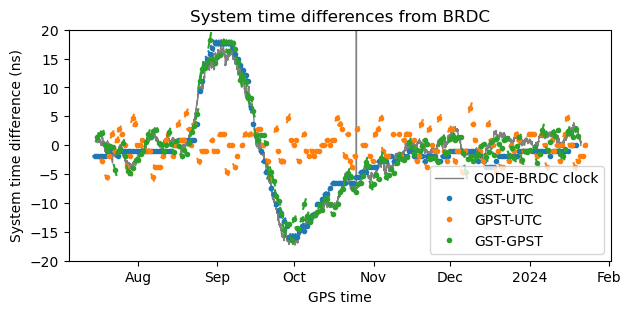In September and October last year I was covering an anomaly with the Galileo GST-UTC offset (see also the update). I planned to keep posting updates as the event progressed, or at least once it was over, but I soon got distracted with other things, and this event didn’t get enough media coverage that would serve me as a reminder.
As a quick reminder, the Galileo GNSS maintains a timescale known as GST. This timescale is usually within a few nanoseconds of UTC, as is also the case for GPS time (although both GNSS systems give much larger margins when defining how much their timescales can deviate from UTC). In the beginning of September 2023, the GST-UTC offset reached a value of around 20 ns, much larger than it usually is. This surprised some people in the GNSS community, and I don’t recall there being a public explanation about what had happened.
Now this event is well past, so I can update my plots to show it in its full duration. For more details, refer to the first post. For this post I have used data ranging from 2023-07-16 to 2024-01-20. As in the previous posts, the data I’m using is the precise clock solution from CODE (the final products) and the broadcast ephemerides from IGS.
The difference between the broadcast ephemerides clock bias and the CODE precise clock bias is shown here. This quantity is a proxy for the GST-GPST offset, because CODE refers the timescale for its precise solutions to GPST. Since GPST is within a few ns of UTC, this is a good approximation for the GST-UTC offset.

There is a glitch in the data sometime in October. I haven’t investigated this, and we can safely ignored it. We can see that the GST-UTC reaches nearly -20 ns in the beginning of September, then swings in the opposite direction, reaching almost 20 ns in the beginning of October, and then it takes all October and part of November before resuming usual levels around zero. I have included some data before August to show how the offset behaved before the anomaly began. It is clear that the behaviour in July and December is similar, so we can say that the system was restored mid-November.
The second plot I had was a comparison of the three offsets that are included in the broadcast ephemerides (GST-UTC, GPST-UTC, and GST-UTC) with the curve obtained above as the average of all Galileo satellites (with the sign flipped, due to sign conventions in the biases).

Besides the fact that the broadcast GST-UTC and GST-GPST biases follow quite closely the curve of the CODE-BRDC clock, there are other details that are quite apparent in this long term plot.
The first is that the GPST-UTC is quite noisy. Note that this isn’t part of Galileo. It is transmitted by the GPS constellation. It also seems that there is a positive correlation between the sign of the GPST-UTC and the sign of its derivative (the derivative is represented by a short slanted line crossing the point in question). Certainly, if we subtract the GST-UTC and GST-GPST offsets provided by Galileo, we obtain something much smaller than what GPS broadcasts as GPST-UTC.
The second is that the GST-UTC offset is sometimes held constant for periods of several weeks. In comparison, the GST-GPST varies more quickly. This makes sense, because measuring GST-UTC requires processing data from stations that are equipped with a Galileo timing receiver and that also have traceability to UTC, while measuring GST-GPST is something that any GNSS receiver can do with the ephemerides of both systems and observations of satellites in the two constellations.
I have updated the Jupyter notebook and the data used for this post in the repository.
Shades of the previous total loss of timing – did they do enough to prevent it from ever happening again, or was that too expensive?
Hats off to the maintainers of GPS time! It’s not trivial to steer something to within a few ns of UTC, in real time, and keep it there for a decade.
Thanks as always for the interesting writeup.